Pedagogical Grammar: EAL Speech Analysis and Language Acquisition
VerifiedAdded on 2023/06/11
|17
|4568
|306
Essay
AI Summary
This essay presents a pedagogical grammar analysis of a Spanish speaker learning English as a second language, focusing on phonological transference, sentence structure, and communicative grammar. The analysis examines the influence of Spanish on the speaker's English pronunciation, including consonant and vowel sounds, and identifies challenges related to nasals, fricatives, and glottal sounds. Sentence structure differences, such as negation and subject-verb agreement, are also explored. The essay discusses the speaker's communicative competence and accuracy, and applies Stephen Krashen's monitor model theory to explain the speaker's language acquisition process. The challenges faced by the speaker, including pronunciation difficulties and grammatical errors, are highlighted, providing insights into second language learning.
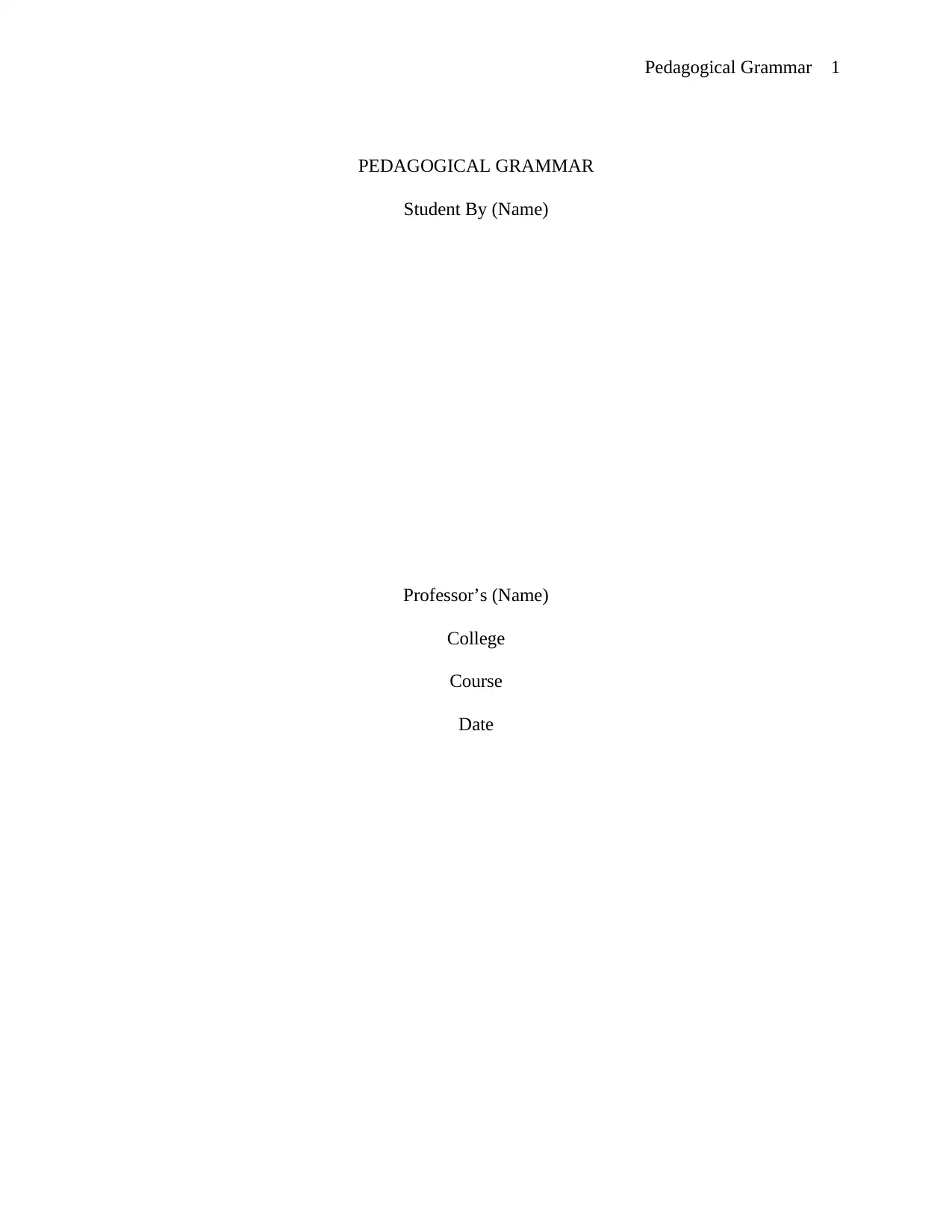
Pedagogical Grammar 1
PEDAGOGICAL GRAMMAR
Student By (Name)
Professor’s (Name)
College
Course
Date
PEDAGOGICAL GRAMMAR
Student By (Name)
Professor’s (Name)
College
Course
Date
Paraphrase This Document
Need a fresh take? Get an instant paraphrase of this document with our AI Paraphraser
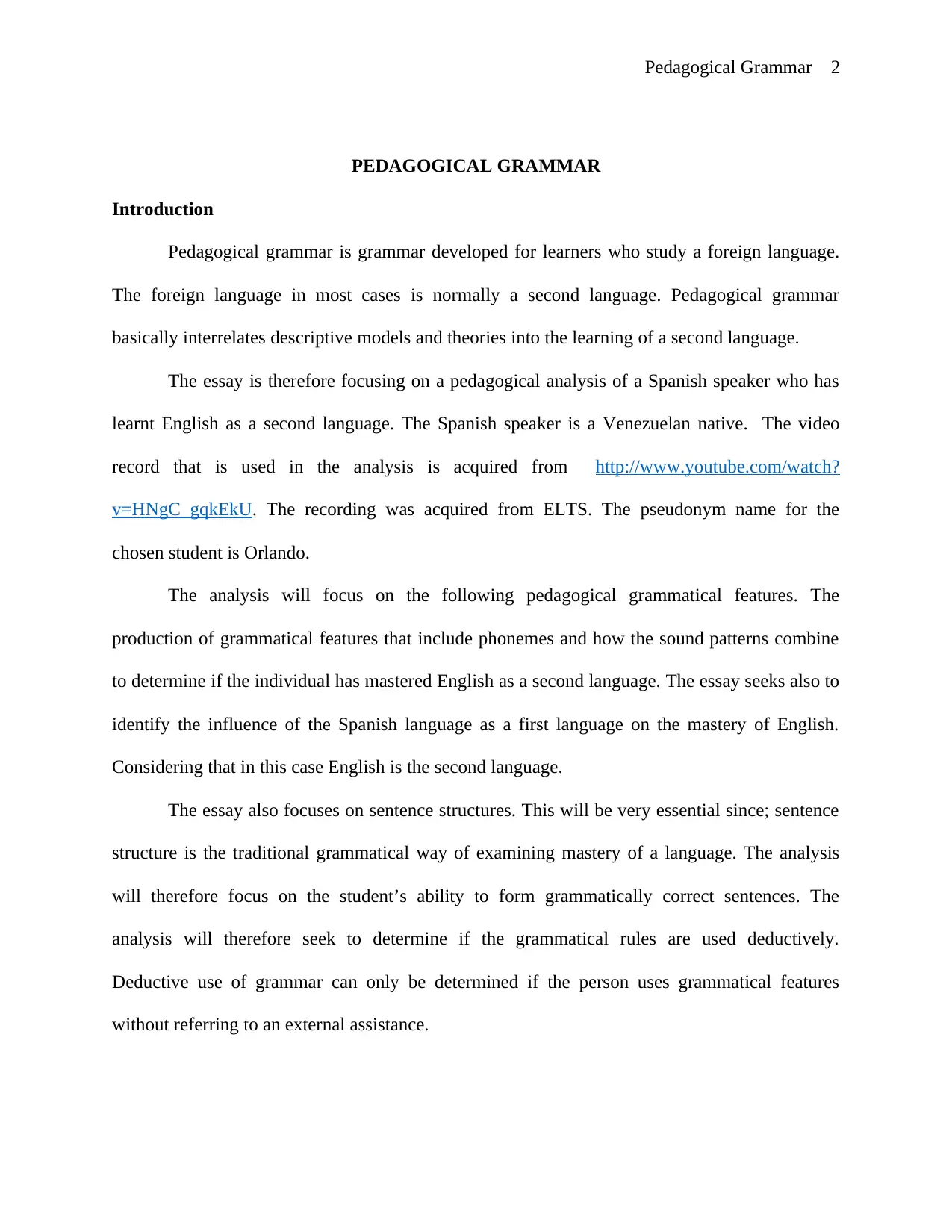
Pedagogical Grammar 2
PEDAGOGICAL GRAMMAR
Introduction
Pedagogical grammar is grammar developed for learners who study a foreign language.
The foreign language in most cases is normally a second language. Pedagogical grammar
basically interrelates descriptive models and theories into the learning of a second language.
The essay is therefore focusing on a pedagogical analysis of a Spanish speaker who has
learnt English as a second language. The Spanish speaker is a Venezuelan native. The video
record that is used in the analysis is acquired from http://www.youtube.com/watch?
v=HNgC_gqkEkU. The recording was acquired from ELTS. The pseudonym name for the
chosen student is Orlando.
The analysis will focus on the following pedagogical grammatical features. The
production of grammatical features that include phonemes and how the sound patterns combine
to determine if the individual has mastered English as a second language. The essay seeks also to
identify the influence of the Spanish language as a first language on the mastery of English.
Considering that in this case English is the second language.
The essay also focuses on sentence structures. This will be very essential since; sentence
structure is the traditional grammatical way of examining mastery of a language. The analysis
will therefore focus on the student’s ability to form grammatically correct sentences. The
analysis will therefore seek to determine if the grammatical rules are used deductively.
Deductive use of grammar can only be determined if the person uses grammatical features
without referring to an external assistance.
PEDAGOGICAL GRAMMAR
Introduction
Pedagogical grammar is grammar developed for learners who study a foreign language.
The foreign language in most cases is normally a second language. Pedagogical grammar
basically interrelates descriptive models and theories into the learning of a second language.
The essay is therefore focusing on a pedagogical analysis of a Spanish speaker who has
learnt English as a second language. The Spanish speaker is a Venezuelan native. The video
record that is used in the analysis is acquired from http://www.youtube.com/watch?
v=HNgC_gqkEkU. The recording was acquired from ELTS. The pseudonym name for the
chosen student is Orlando.
The analysis will focus on the following pedagogical grammatical features. The
production of grammatical features that include phonemes and how the sound patterns combine
to determine if the individual has mastered English as a second language. The essay seeks also to
identify the influence of the Spanish language as a first language on the mastery of English.
Considering that in this case English is the second language.
The essay also focuses on sentence structures. This will be very essential since; sentence
structure is the traditional grammatical way of examining mastery of a language. The analysis
will therefore focus on the student’s ability to form grammatically correct sentences. The
analysis will therefore seek to determine if the grammatical rules are used deductively.
Deductive use of grammar can only be determined if the person uses grammatical features
without referring to an external assistance.
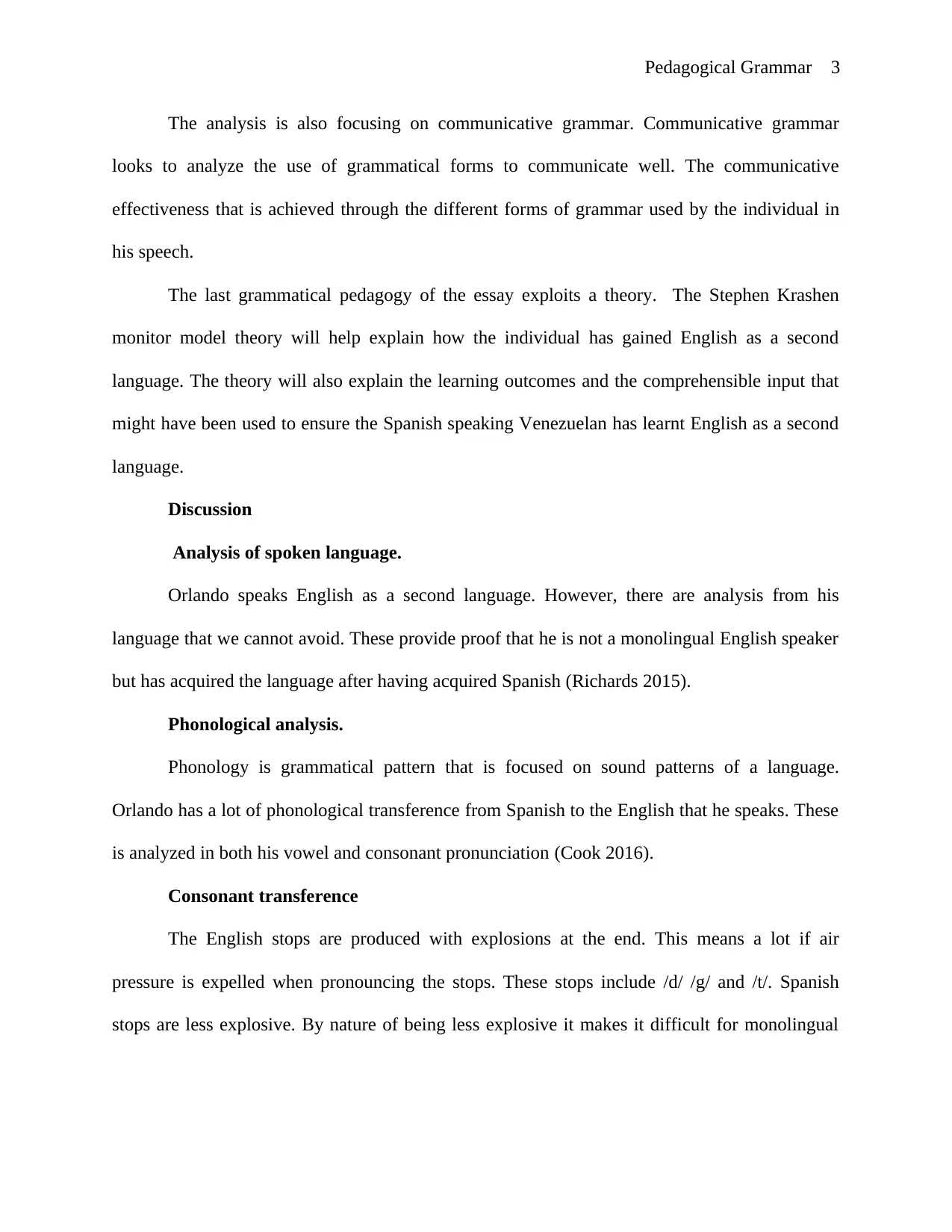
Pedagogical Grammar 3
The analysis is also focusing on communicative grammar. Communicative grammar
looks to analyze the use of grammatical forms to communicate well. The communicative
effectiveness that is achieved through the different forms of grammar used by the individual in
his speech.
The last grammatical pedagogy of the essay exploits a theory. The Stephen Krashen
monitor model theory will help explain how the individual has gained English as a second
language. The theory will also explain the learning outcomes and the comprehensible input that
might have been used to ensure the Spanish speaking Venezuelan has learnt English as a second
language.
Discussion
Analysis of spoken language.
Orlando speaks English as a second language. However, there are analysis from his
language that we cannot avoid. These provide proof that he is not a monolingual English speaker
but has acquired the language after having acquired Spanish (Richards 2015).
Phonological analysis.
Phonology is grammatical pattern that is focused on sound patterns of a language.
Orlando has a lot of phonological transference from Spanish to the English that he speaks. These
is analyzed in both his vowel and consonant pronunciation (Cook 2016).
Consonant transference
The English stops are produced with explosions at the end. This means a lot if air
pressure is expelled when pronouncing the stops. These stops include /d/ /g/ and /t/. Spanish
stops are less explosive. By nature of being less explosive it makes it difficult for monolingual
The analysis is also focusing on communicative grammar. Communicative grammar
looks to analyze the use of grammatical forms to communicate well. The communicative
effectiveness that is achieved through the different forms of grammar used by the individual in
his speech.
The last grammatical pedagogy of the essay exploits a theory. The Stephen Krashen
monitor model theory will help explain how the individual has gained English as a second
language. The theory will also explain the learning outcomes and the comprehensible input that
might have been used to ensure the Spanish speaking Venezuelan has learnt English as a second
language.
Discussion
Analysis of spoken language.
Orlando speaks English as a second language. However, there are analysis from his
language that we cannot avoid. These provide proof that he is not a monolingual English speaker
but has acquired the language after having acquired Spanish (Richards 2015).
Phonological analysis.
Phonology is grammatical pattern that is focused on sound patterns of a language.
Orlando has a lot of phonological transference from Spanish to the English that he speaks. These
is analyzed in both his vowel and consonant pronunciation (Cook 2016).
Consonant transference
The English stops are produced with explosions at the end. This means a lot if air
pressure is expelled when pronouncing the stops. These stops include /d/ /g/ and /t/. Spanish
stops are less explosive. By nature of being less explosive it makes it difficult for monolingual
⊘ This is a preview!⊘
Do you want full access?
Subscribe today to unlock all pages.

Trusted by 1+ million students worldwide
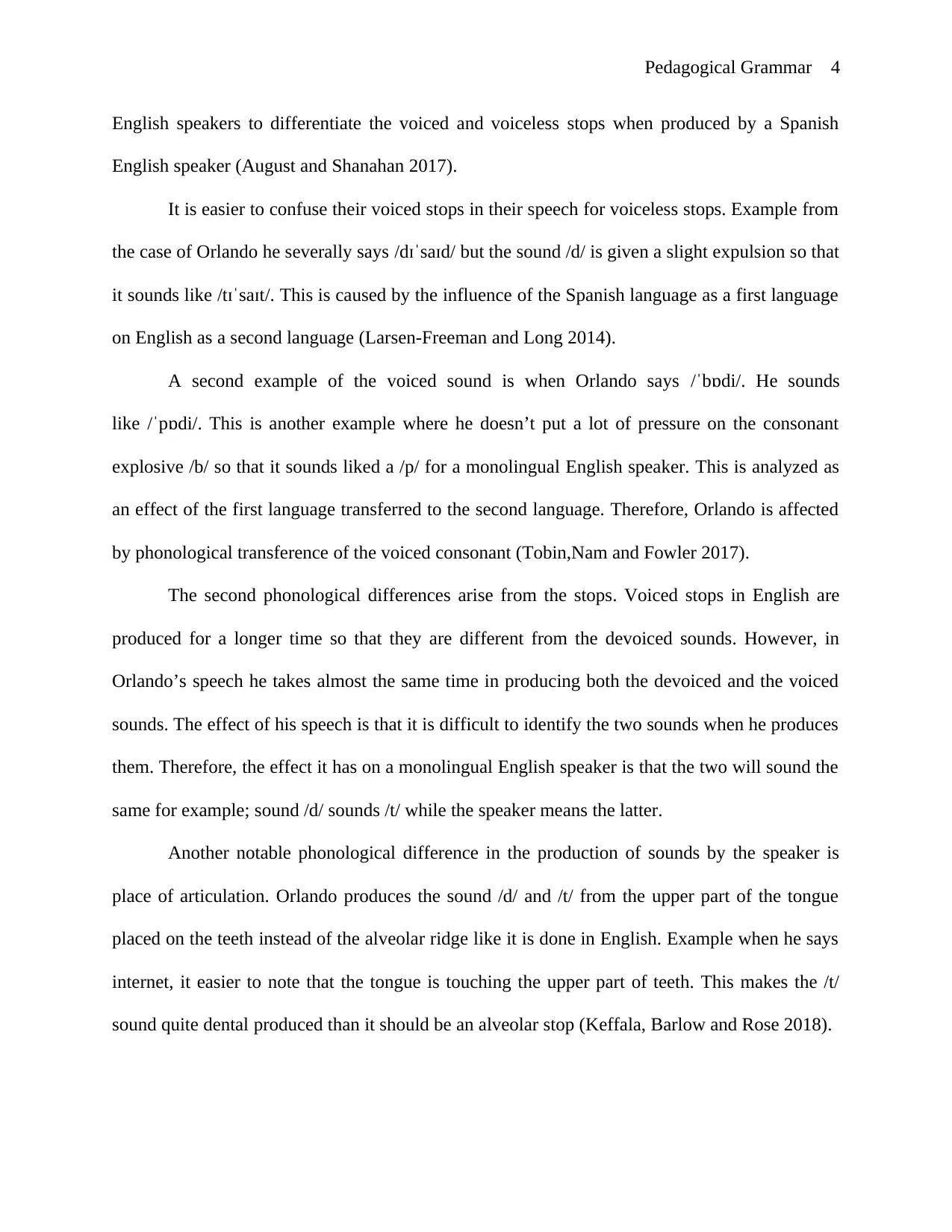
Pedagogical Grammar 4
English speakers to differentiate the voiced and voiceless stops when produced by a Spanish
English speaker (August and Shanahan 2017).
It is easier to confuse their voiced stops in their speech for voiceless stops. Example from
the case of Orlando he severally says /dɪˈsaɪd/ but the sound /d/ is given a slight expulsion so that
it sounds like /tɪˈsaɪt/. This is caused by the influence of the Spanish language as a first language
on English as a second language (Larsen-Freeman and Long 2014).
A second example of the voiced sound is when Orlando says /ˈbɒdi/. He sounds
like /ˈpɒdi/. This is another example where he doesn’t put a lot of pressure on the consonant
explosive /b/ so that it sounds liked a /p/ for a monolingual English speaker. This is analyzed as
an effect of the first language transferred to the second language. Therefore, Orlando is affected
by phonological transference of the voiced consonant (Tobin,Nam and Fowler 2017).
The second phonological differences arise from the stops. Voiced stops in English are
produced for a longer time so that they are different from the devoiced sounds. However, in
Orlando’s speech he takes almost the same time in producing both the devoiced and the voiced
sounds. The effect of his speech is that it is difficult to identify the two sounds when he produces
them. Therefore, the effect it has on a monolingual English speaker is that the two will sound the
same for example; sound /d/ sounds /t/ while the speaker means the latter.
Another notable phonological difference in the production of sounds by the speaker is
place of articulation. Orlando produces the sound /d/ and /t/ from the upper part of the tongue
placed on the teeth instead of the alveolar ridge like it is done in English. Example when he says
internet, it easier to note that the tongue is touching the upper part of teeth. This makes the /t/
sound quite dental produced than it should be an alveolar stop (Keffala, Barlow and Rose 2018).
English speakers to differentiate the voiced and voiceless stops when produced by a Spanish
English speaker (August and Shanahan 2017).
It is easier to confuse their voiced stops in their speech for voiceless stops. Example from
the case of Orlando he severally says /dɪˈsaɪd/ but the sound /d/ is given a slight expulsion so that
it sounds like /tɪˈsaɪt/. This is caused by the influence of the Spanish language as a first language
on English as a second language (Larsen-Freeman and Long 2014).
A second example of the voiced sound is when Orlando says /ˈbɒdi/. He sounds
like /ˈpɒdi/. This is another example where he doesn’t put a lot of pressure on the consonant
explosive /b/ so that it sounds liked a /p/ for a monolingual English speaker. This is analyzed as
an effect of the first language transferred to the second language. Therefore, Orlando is affected
by phonological transference of the voiced consonant (Tobin,Nam and Fowler 2017).
The second phonological differences arise from the stops. Voiced stops in English are
produced for a longer time so that they are different from the devoiced sounds. However, in
Orlando’s speech he takes almost the same time in producing both the devoiced and the voiced
sounds. The effect of his speech is that it is difficult to identify the two sounds when he produces
them. Therefore, the effect it has on a monolingual English speaker is that the two will sound the
same for example; sound /d/ sounds /t/ while the speaker means the latter.
Another notable phonological difference in the production of sounds by the speaker is
place of articulation. Orlando produces the sound /d/ and /t/ from the upper part of the tongue
placed on the teeth instead of the alveolar ridge like it is done in English. Example when he says
internet, it easier to note that the tongue is touching the upper part of teeth. This makes the /t/
sound quite dental produced than it should be an alveolar stop (Keffala, Barlow and Rose 2018).
Paraphrase This Document
Need a fresh take? Get an instant paraphrase of this document with our AI Paraphraser
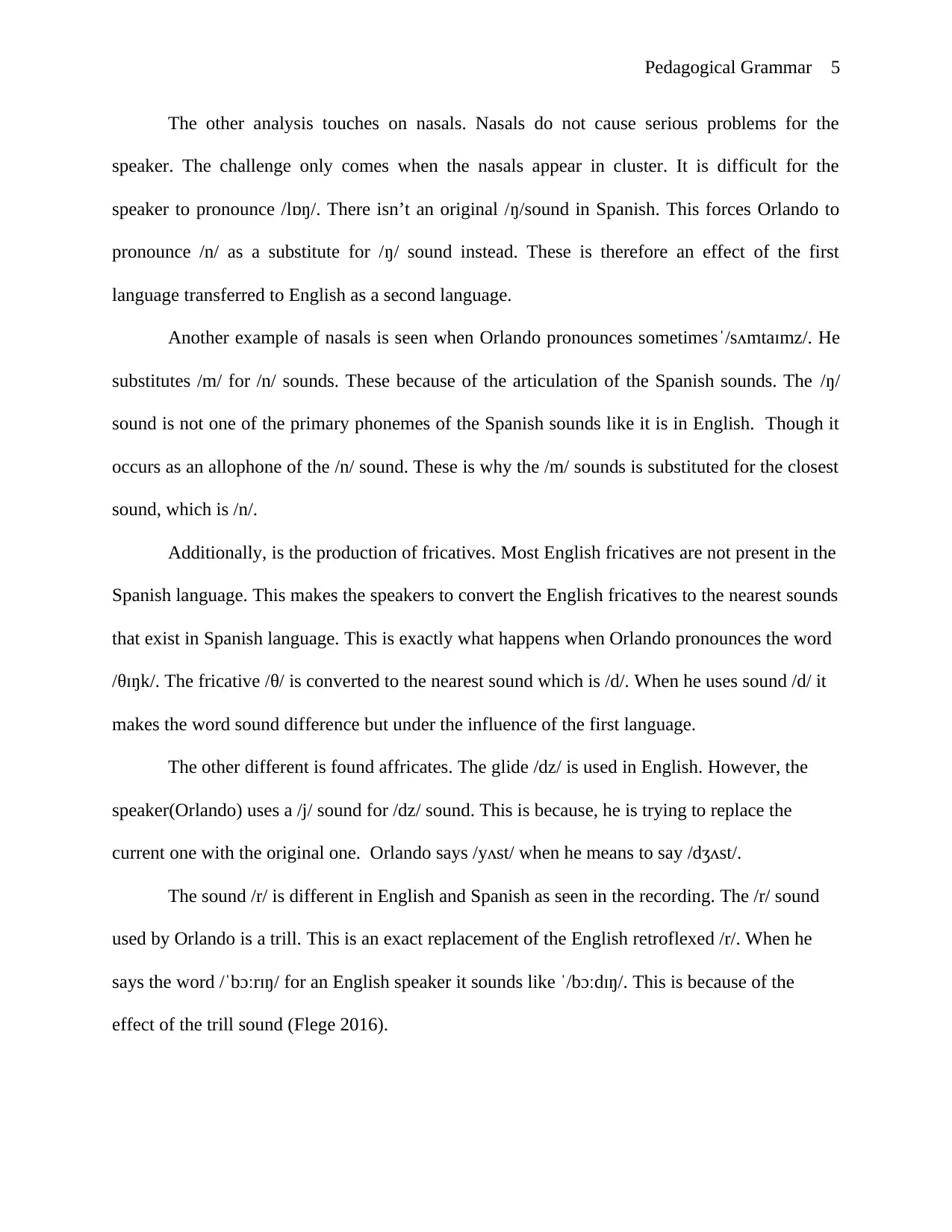
Pedagogical Grammar 5
The other analysis touches on nasals. Nasals do not cause serious problems for the
speaker. The challenge only comes when the nasals appear in cluster. It is difficult for the
speaker to pronounce /lɒŋ/. There isn’t an original /ŋ/sound in Spanish. This forces Orlando to
pronounce /n/ as a substitute for /ŋ/ sound instead. These is therefore an effect of the first
language transferred to English as a second language.
Another example of nasals is seen when Orlando pronounces sometimesˈ/sʌmtaɪmz/. He
substitutes /m/ for /n/ sounds. These because of the articulation of the Spanish sounds. The /ŋ/
sound is not one of the primary phonemes of the Spanish sounds like it is in English. Though it
occurs as an allophone of the /n/ sound. These is why the /m/ sounds is substituted for the closest
sound, which is /n/.
Additionally, is the production of fricatives. Most English fricatives are not present in the
Spanish language. This makes the speakers to convert the English fricatives to the nearest sounds
that exist in Spanish language. This is exactly what happens when Orlando pronounces the word
/θɪŋk/. The fricative /θ/ is converted to the nearest sound which is /d/. When he uses sound /d/ it
makes the word sound difference but under the influence of the first language.
The other different is found affricates. The glide /dz/ is used in English. However, the
speaker(Orlando) uses a /j/ sound for /dz/ sound. This is because, he is trying to replace the
current one with the original one. Orlando says /yʌst/ when he means to say /dʒʌst/.
The sound /r/ is different in English and Spanish as seen in the recording. The /r/ sound
used by Orlando is a trill. This is an exact replacement of the English retroflexed /r/. When he
says the word /ˈbɔːrɪŋ/ for an English speaker it sounds like ˈ/bɔːdɪŋ/. This is because of the
effect of the trill sound (Flege 2016).
The other analysis touches on nasals. Nasals do not cause serious problems for the
speaker. The challenge only comes when the nasals appear in cluster. It is difficult for the
speaker to pronounce /lɒŋ/. There isn’t an original /ŋ/sound in Spanish. This forces Orlando to
pronounce /n/ as a substitute for /ŋ/ sound instead. These is therefore an effect of the first
language transferred to English as a second language.
Another example of nasals is seen when Orlando pronounces sometimesˈ/sʌmtaɪmz/. He
substitutes /m/ for /n/ sounds. These because of the articulation of the Spanish sounds. The /ŋ/
sound is not one of the primary phonemes of the Spanish sounds like it is in English. Though it
occurs as an allophone of the /n/ sound. These is why the /m/ sounds is substituted for the closest
sound, which is /n/.
Additionally, is the production of fricatives. Most English fricatives are not present in the
Spanish language. This makes the speakers to convert the English fricatives to the nearest sounds
that exist in Spanish language. This is exactly what happens when Orlando pronounces the word
/θɪŋk/. The fricative /θ/ is converted to the nearest sound which is /d/. When he uses sound /d/ it
makes the word sound difference but under the influence of the first language.
The other different is found affricates. The glide /dz/ is used in English. However, the
speaker(Orlando) uses a /j/ sound for /dz/ sound. This is because, he is trying to replace the
current one with the original one. Orlando says /yʌst/ when he means to say /dʒʌst/.
The sound /r/ is different in English and Spanish as seen in the recording. The /r/ sound
used by Orlando is a trill. This is an exact replacement of the English retroflexed /r/. When he
says the word /ˈbɔːrɪŋ/ for an English speaker it sounds like ˈ/bɔːdɪŋ/. This is because of the
effect of the trill sound (Flege 2016).

Pedagogical Grammar 6
When Orlando says the word /ˈjestə(r)deɪ/ it sounds like /dzestə(r)deɪ/. This is because of
the pronunciation of the initial sound. The Spanish speaker consider the two glides as allophones.
This is because, it is likely that original Spanish language does not have original form of /j/,
therefore they consider it to the nearest allophone which is the glide /dz/ (Dmitri Eva,
Llanos,Shultz and Francis 2015).
Glottal sounds
The initial /h/ sound is silent in Spanish sounds which is not the case in English. In
Orlando’s speech it is common to hear him say /aʊ/ instead of /haʊ/. This is effect of the Spanish
transference to English. The velar constriction that English speakers have is therefore not there
for Spanish speakers who learn English as second language (Balukas and Koops 2015).
Phono-tactic constraints
The speaker shows a lot of differences when addressing the consonant clusters.
Especially consonant clusters that appear as initial and final sounds. For Spanish first language
speakers like Orlando, some consonant combination cannot come as final sound therefore they
are forced to transfer this when speaking English. For example, when sounds / n/ and /d/ form a
cluster as final sound. When Orlando says /saʊn/ instead of /saʊnd/, it is because of the effect of
the Spanish sound (Yavas 2016).
The other effect is that initial sound /s/ which in Spanish can only occur when it is
preceded by the sound /e/. In Orlando speech we often hear the word /estɔːr/ instead of /stɔː(r)/.
This is effect of the transference of the Spanish phonetic constraints to English phonetic
constraints (Yavas 2016).
Sentence structure differences
Negation
When Orlando says the word /ˈjestə(r)deɪ/ it sounds like /dzestə(r)deɪ/. This is because of
the pronunciation of the initial sound. The Spanish speaker consider the two glides as allophones.
This is because, it is likely that original Spanish language does not have original form of /j/,
therefore they consider it to the nearest allophone which is the glide /dz/ (Dmitri Eva,
Llanos,Shultz and Francis 2015).
Glottal sounds
The initial /h/ sound is silent in Spanish sounds which is not the case in English. In
Orlando’s speech it is common to hear him say /aʊ/ instead of /haʊ/. This is effect of the Spanish
transference to English. The velar constriction that English speakers have is therefore not there
for Spanish speakers who learn English as second language (Balukas and Koops 2015).
Phono-tactic constraints
The speaker shows a lot of differences when addressing the consonant clusters.
Especially consonant clusters that appear as initial and final sounds. For Spanish first language
speakers like Orlando, some consonant combination cannot come as final sound therefore they
are forced to transfer this when speaking English. For example, when sounds / n/ and /d/ form a
cluster as final sound. When Orlando says /saʊn/ instead of /saʊnd/, it is because of the effect of
the Spanish sound (Yavas 2016).
The other effect is that initial sound /s/ which in Spanish can only occur when it is
preceded by the sound /e/. In Orlando speech we often hear the word /estɔːr/ instead of /stɔː(r)/.
This is effect of the transference of the Spanish phonetic constraints to English phonetic
constraints (Yavas 2016).
Sentence structure differences
Negation
⊘ This is a preview!⊘
Do you want full access?
Subscribe today to unlock all pages.

Trusted by 1+ million students worldwide

Pedagogical Grammar 7
In English negation. The prefixes for negation is used. These prefixes include im, un. and
in. This is not the case for the recording. Orlando uses the Spanish form where the word no is
prefixed before the word. It is common to here Orlando say no sure to mean not sure. This is due
to the effect of the first language (Solon 2017).
Subject verb agreement
English sentence begins with subjects. Then they are followed by verbs example
(Herman is my friend). In Orlando speech he begins the sentence with the verb, then the noun
comes after. Instead of the S.V.O in English he uses the V.S.O. This is noted when he says Is my
best friend Herman. English only uses this for interrogative mood but not imperative. These is
assumed to be the influence of the first language which is Spanish on English as a second
language (Baker 2018).
Comparative adjectives
English comparative adjectives are formed differently. The conventional way however is
suffixing the adjective with an (er). For example, tall – taller. In a sentence the word that follows
the comparative adjective is than. For example, (she is taller than me). Orlando makes a
grammatical error. He says, ‘I am more tall than my friend’. This is the effect of the first
language to the second language learning (Baker 2018).
Communicative grammar
Orlando can communicate well. His communicative grammar skills are very good. He
shows very good understanding of all questions. He gives full answers of the questions asked.
There is good use of intonation. He chooses his expressions and idioms very well. He combines
complex language and simple language very well. He speaks quick and fluently. This explains
his ability to communicate using English very well. It is therefore right to conclude that Orlando
In English negation. The prefixes for negation is used. These prefixes include im, un. and
in. This is not the case for the recording. Orlando uses the Spanish form where the word no is
prefixed before the word. It is common to here Orlando say no sure to mean not sure. This is due
to the effect of the first language (Solon 2017).
Subject verb agreement
English sentence begins with subjects. Then they are followed by verbs example
(Herman is my friend). In Orlando speech he begins the sentence with the verb, then the noun
comes after. Instead of the S.V.O in English he uses the V.S.O. This is noted when he says Is my
best friend Herman. English only uses this for interrogative mood but not imperative. These is
assumed to be the influence of the first language which is Spanish on English as a second
language (Baker 2018).
Comparative adjectives
English comparative adjectives are formed differently. The conventional way however is
suffixing the adjective with an (er). For example, tall – taller. In a sentence the word that follows
the comparative adjective is than. For example, (she is taller than me). Orlando makes a
grammatical error. He says, ‘I am more tall than my friend’. This is the effect of the first
language to the second language learning (Baker 2018).
Communicative grammar
Orlando can communicate well. His communicative grammar skills are very good. He
shows very good understanding of all questions. He gives full answers of the questions asked.
There is good use of intonation. He chooses his expressions and idioms very well. He combines
complex language and simple language very well. He speaks quick and fluently. This explains
his ability to communicate using English very well. It is therefore right to conclude that Orlando
Paraphrase This Document
Need a fresh take? Get an instant paraphrase of this document with our AI Paraphraser
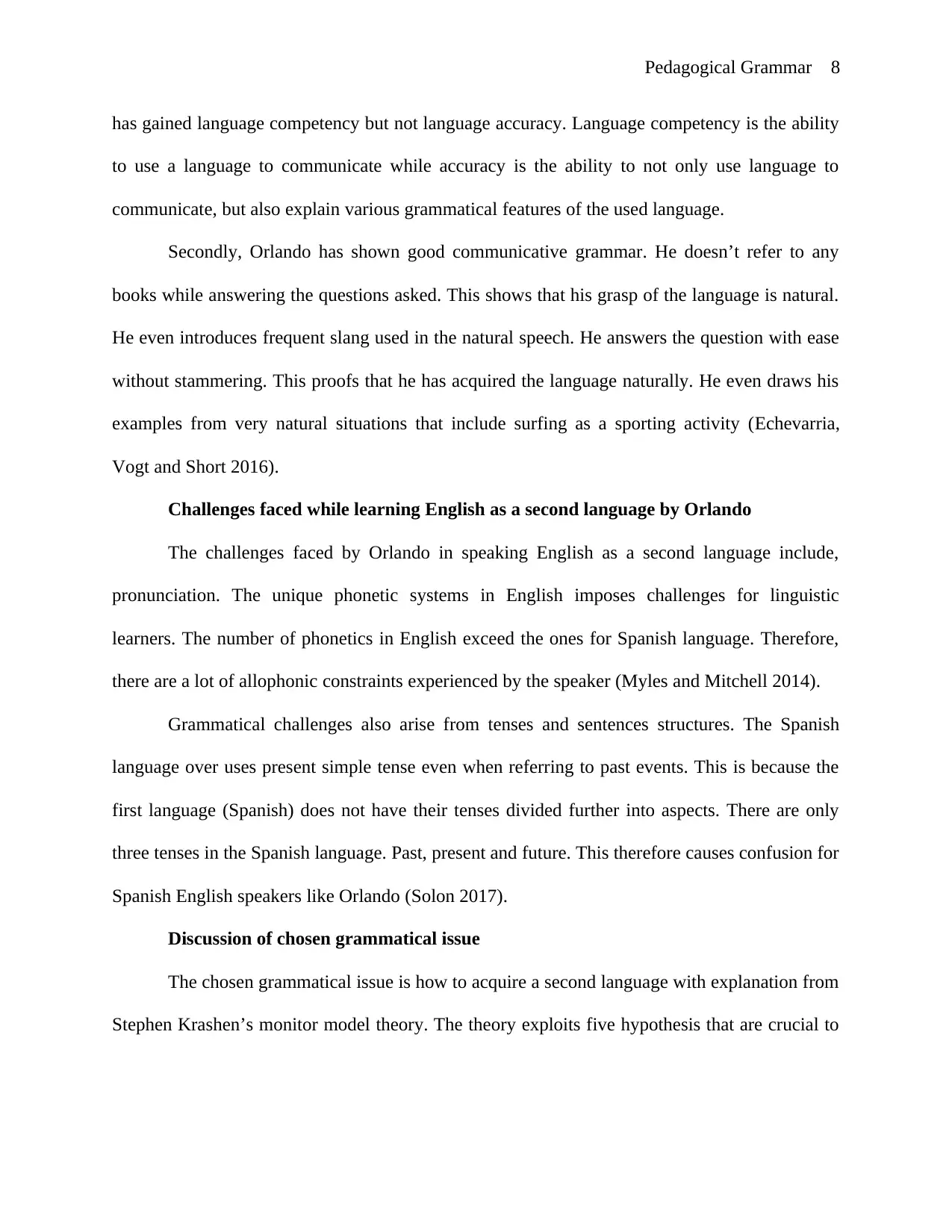
Pedagogical Grammar 8
has gained language competency but not language accuracy. Language competency is the ability
to use a language to communicate while accuracy is the ability to not only use language to
communicate, but also explain various grammatical features of the used language.
Secondly, Orlando has shown good communicative grammar. He doesn’t refer to any
books while answering the questions asked. This shows that his grasp of the language is natural.
He even introduces frequent slang used in the natural speech. He answers the question with ease
without stammering. This proofs that he has acquired the language naturally. He even draws his
examples from very natural situations that include surfing as a sporting activity (Echevarria,
Vogt and Short 2016).
Challenges faced while learning English as a second language by Orlando
The challenges faced by Orlando in speaking English as a second language include,
pronunciation. The unique phonetic systems in English imposes challenges for linguistic
learners. The number of phonetics in English exceed the ones for Spanish language. Therefore,
there are a lot of allophonic constraints experienced by the speaker (Myles and Mitchell 2014).
Grammatical challenges also arise from tenses and sentences structures. The Spanish
language over uses present simple tense even when referring to past events. This is because the
first language (Spanish) does not have their tenses divided further into aspects. There are only
three tenses in the Spanish language. Past, present and future. This therefore causes confusion for
Spanish English speakers like Orlando (Solon 2017).
Discussion of chosen grammatical issue
The chosen grammatical issue is how to acquire a second language with explanation from
Stephen Krashen’s monitor model theory. The theory exploits five hypothesis that are crucial to
has gained language competency but not language accuracy. Language competency is the ability
to use a language to communicate while accuracy is the ability to not only use language to
communicate, but also explain various grammatical features of the used language.
Secondly, Orlando has shown good communicative grammar. He doesn’t refer to any
books while answering the questions asked. This shows that his grasp of the language is natural.
He even introduces frequent slang used in the natural speech. He answers the question with ease
without stammering. This proofs that he has acquired the language naturally. He even draws his
examples from very natural situations that include surfing as a sporting activity (Echevarria,
Vogt and Short 2016).
Challenges faced while learning English as a second language by Orlando
The challenges faced by Orlando in speaking English as a second language include,
pronunciation. The unique phonetic systems in English imposes challenges for linguistic
learners. The number of phonetics in English exceed the ones for Spanish language. Therefore,
there are a lot of allophonic constraints experienced by the speaker (Myles and Mitchell 2014).
Grammatical challenges also arise from tenses and sentences structures. The Spanish
language over uses present simple tense even when referring to past events. This is because the
first language (Spanish) does not have their tenses divided further into aspects. There are only
three tenses in the Spanish language. Past, present and future. This therefore causes confusion for
Spanish English speakers like Orlando (Solon 2017).
Discussion of chosen grammatical issue
The chosen grammatical issue is how to acquire a second language with explanation from
Stephen Krashen’s monitor model theory. The theory exploits five hypothesis that are crucial to
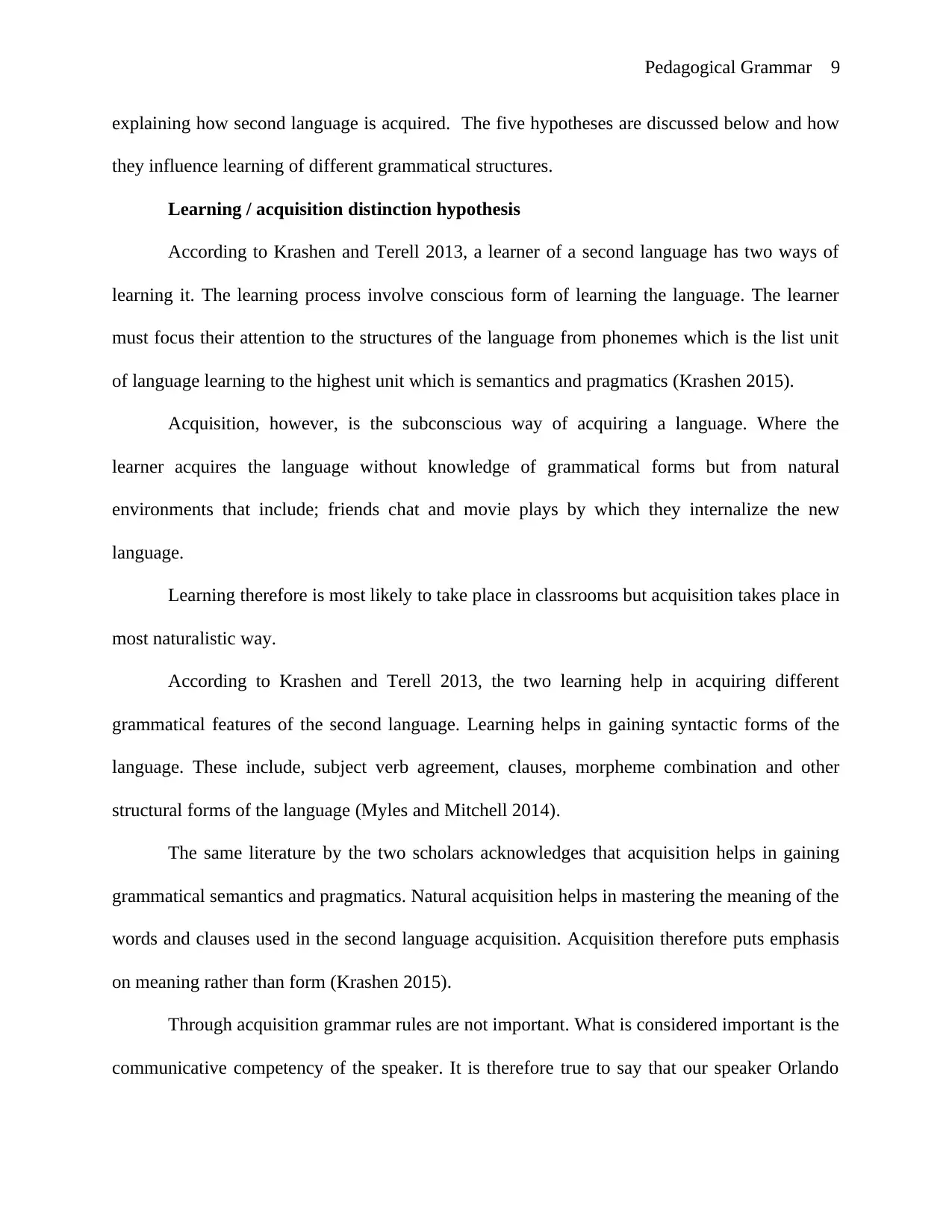
Pedagogical Grammar 9
explaining how second language is acquired. The five hypotheses are discussed below and how
they influence learning of different grammatical structures.
Learning / acquisition distinction hypothesis
According to Krashen and Terell 2013, a learner of a second language has two ways of
learning it. The learning process involve conscious form of learning the language. The learner
must focus their attention to the structures of the language from phonemes which is the list unit
of language learning to the highest unit which is semantics and pragmatics (Krashen 2015).
Acquisition, however, is the subconscious way of acquiring a language. Where the
learner acquires the language without knowledge of grammatical forms but from natural
environments that include; friends chat and movie plays by which they internalize the new
language.
Learning therefore is most likely to take place in classrooms but acquisition takes place in
most naturalistic way.
According to Krashen and Terell 2013, the two learning help in acquiring different
grammatical features of the second language. Learning helps in gaining syntactic forms of the
language. These include, subject verb agreement, clauses, morpheme combination and other
structural forms of the language (Myles and Mitchell 2014).
The same literature by the two scholars acknowledges that acquisition helps in gaining
grammatical semantics and pragmatics. Natural acquisition helps in mastering the meaning of the
words and clauses used in the second language acquisition. Acquisition therefore puts emphasis
on meaning rather than form (Krashen 2015).
Through acquisition grammar rules are not important. What is considered important is the
communicative competency of the speaker. It is therefore true to say that our speaker Orlando
explaining how second language is acquired. The five hypotheses are discussed below and how
they influence learning of different grammatical structures.
Learning / acquisition distinction hypothesis
According to Krashen and Terell 2013, a learner of a second language has two ways of
learning it. The learning process involve conscious form of learning the language. The learner
must focus their attention to the structures of the language from phonemes which is the list unit
of language learning to the highest unit which is semantics and pragmatics (Krashen 2015).
Acquisition, however, is the subconscious way of acquiring a language. Where the
learner acquires the language without knowledge of grammatical forms but from natural
environments that include; friends chat and movie plays by which they internalize the new
language.
Learning therefore is most likely to take place in classrooms but acquisition takes place in
most naturalistic way.
According to Krashen and Terell 2013, the two learning help in acquiring different
grammatical features of the second language. Learning helps in gaining syntactic forms of the
language. These include, subject verb agreement, clauses, morpheme combination and other
structural forms of the language (Myles and Mitchell 2014).
The same literature by the two scholars acknowledges that acquisition helps in gaining
grammatical semantics and pragmatics. Natural acquisition helps in mastering the meaning of the
words and clauses used in the second language acquisition. Acquisition therefore puts emphasis
on meaning rather than form (Krashen 2015).
Through acquisition grammar rules are not important. What is considered important is the
communicative competency of the speaker. It is therefore true to say that our speaker Orlando
⊘ This is a preview!⊘
Do you want full access?
Subscribe today to unlock all pages.

Trusted by 1+ million students worldwide
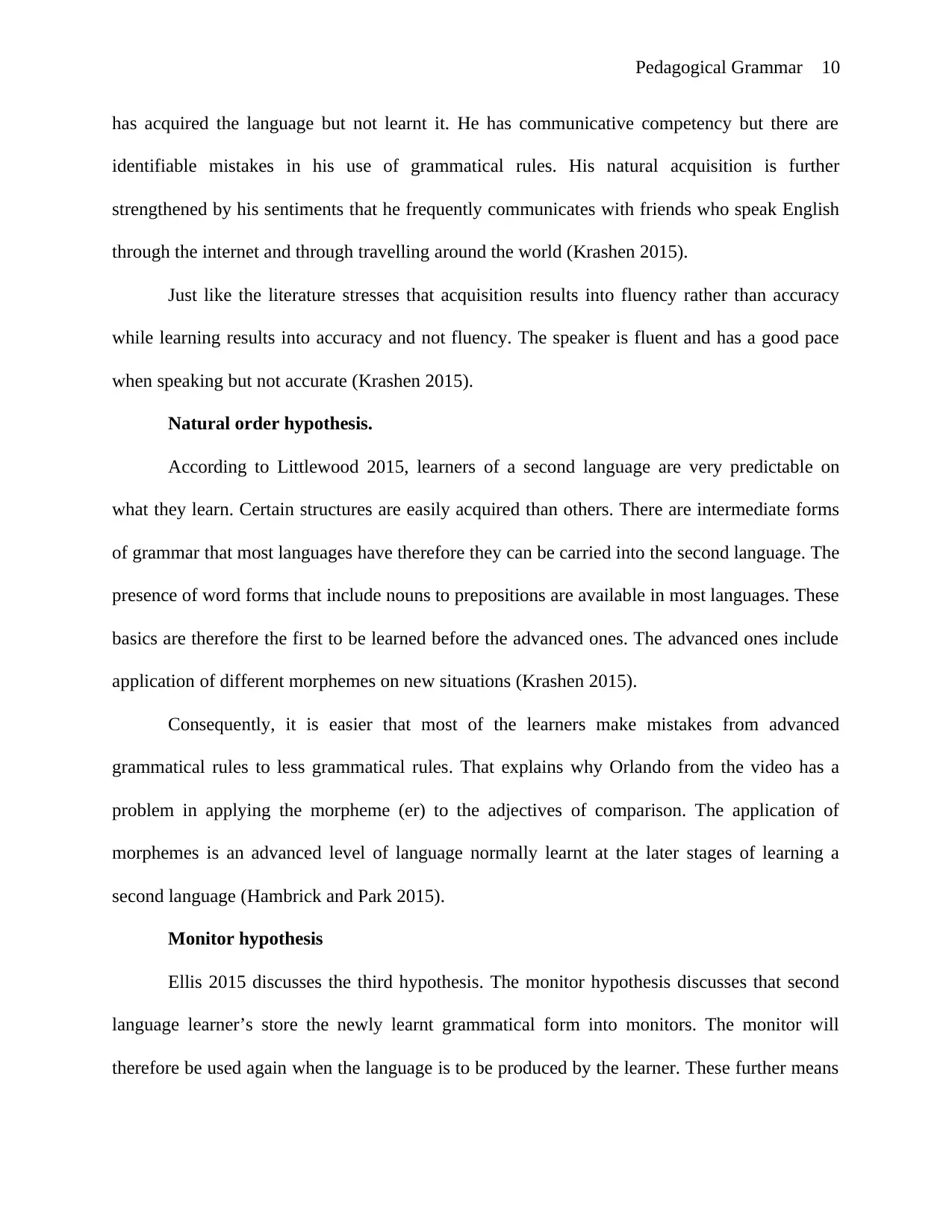
Pedagogical Grammar 10
has acquired the language but not learnt it. He has communicative competency but there are
identifiable mistakes in his use of grammatical rules. His natural acquisition is further
strengthened by his sentiments that he frequently communicates with friends who speak English
through the internet and through travelling around the world (Krashen 2015).
Just like the literature stresses that acquisition results into fluency rather than accuracy
while learning results into accuracy and not fluency. The speaker is fluent and has a good pace
when speaking but not accurate (Krashen 2015).
Natural order hypothesis.
According to Littlewood 2015, learners of a second language are very predictable on
what they learn. Certain structures are easily acquired than others. There are intermediate forms
of grammar that most languages have therefore they can be carried into the second language. The
presence of word forms that include nouns to prepositions are available in most languages. These
basics are therefore the first to be learned before the advanced ones. The advanced ones include
application of different morphemes on new situations (Krashen 2015).
Consequently, it is easier that most of the learners make mistakes from advanced
grammatical rules to less grammatical rules. That explains why Orlando from the video has a
problem in applying the morpheme (er) to the adjectives of comparison. The application of
morphemes is an advanced level of language normally learnt at the later stages of learning a
second language (Hambrick and Park 2015).
Monitor hypothesis
Ellis 2015 discusses the third hypothesis. The monitor hypothesis discusses that second
language learner’s store the newly learnt grammatical form into monitors. The monitor will
therefore be used again when the language is to be produced by the learner. These further means
has acquired the language but not learnt it. He has communicative competency but there are
identifiable mistakes in his use of grammatical rules. His natural acquisition is further
strengthened by his sentiments that he frequently communicates with friends who speak English
through the internet and through travelling around the world (Krashen 2015).
Just like the literature stresses that acquisition results into fluency rather than accuracy
while learning results into accuracy and not fluency. The speaker is fluent and has a good pace
when speaking but not accurate (Krashen 2015).
Natural order hypothesis.
According to Littlewood 2015, learners of a second language are very predictable on
what they learn. Certain structures are easily acquired than others. There are intermediate forms
of grammar that most languages have therefore they can be carried into the second language. The
presence of word forms that include nouns to prepositions are available in most languages. These
basics are therefore the first to be learned before the advanced ones. The advanced ones include
application of different morphemes on new situations (Krashen 2015).
Consequently, it is easier that most of the learners make mistakes from advanced
grammatical rules to less grammatical rules. That explains why Orlando from the video has a
problem in applying the morpheme (er) to the adjectives of comparison. The application of
morphemes is an advanced level of language normally learnt at the later stages of learning a
second language (Hambrick and Park 2015).
Monitor hypothesis
Ellis 2015 discusses the third hypothesis. The monitor hypothesis discusses that second
language learner’s store the newly learnt grammatical form into monitors. The monitor will
therefore be used again when the language is to be produced by the learner. These further means
Paraphrase This Document
Need a fresh take? Get an instant paraphrase of this document with our AI Paraphraser

Pedagogical Grammar 11
that for a student of a second language, they must learn a lot so that their internal monitor is full.
When the learner monitor is full, it easier for the learner to use the language when they need to
(Myles and Mitchell 2014).
When the language user gains the language, the monitor doesn’t give any differences to
how it was acquired. Therefore, monitor will produce it whether it was acquired breaking certain
grammatical rules or respecting these grammatical rules. This means that input is equal to output.
When Orlando uses the words tall instead of taller, that is the way it was stored in his monitor of
the second language at the time he was learning.
Ellis 2015 further recognizes that there are three types of monitor users. Over users. Over
users do not trust their competency in speaking the second language therefore they must use their
monitors quite often. This is normally manifested by increased stammering when speaking the
second language. The individual must think for sometimes before they speak. Orlando is not this
type of user. He easily uses his monitor very less frequently. He produces the answers in English
without stammering or looking for words to use (Roberts, Gonzalez, Pliatsikas and Rothman
2018).
The literature further explains that there are optimal users. These speakers’ use their
monitor not very much and not less often. They seek to achieve correctness therefore they must
refer to their monitor whenever they are not sure what to say. They pose more competence than
those who use their monitor less often. They also manifest good competency than over users.
Orlando is such kind of user since he doesn’t depend on his monitor frequently he just speaks. At
times he uses it. When Orlando is asked about the importance of friendship he requests the other
speaker for more time so that he answers the questions after a minute. These helps him get the
correct grammatical forms from his monitor (Hulstijn 2015).
that for a student of a second language, they must learn a lot so that their internal monitor is full.
When the learner monitor is full, it easier for the learner to use the language when they need to
(Myles and Mitchell 2014).
When the language user gains the language, the monitor doesn’t give any differences to
how it was acquired. Therefore, monitor will produce it whether it was acquired breaking certain
grammatical rules or respecting these grammatical rules. This means that input is equal to output.
When Orlando uses the words tall instead of taller, that is the way it was stored in his monitor of
the second language at the time he was learning.
Ellis 2015 further recognizes that there are three types of monitor users. Over users. Over
users do not trust their competency in speaking the second language therefore they must use their
monitors quite often. This is normally manifested by increased stammering when speaking the
second language. The individual must think for sometimes before they speak. Orlando is not this
type of user. He easily uses his monitor very less frequently. He produces the answers in English
without stammering or looking for words to use (Roberts, Gonzalez, Pliatsikas and Rothman
2018).
The literature further explains that there are optimal users. These speakers’ use their
monitor not very much and not less often. They seek to achieve correctness therefore they must
refer to their monitor whenever they are not sure what to say. They pose more competence than
those who use their monitor less often. They also manifest good competency than over users.
Orlando is such kind of user since he doesn’t depend on his monitor frequently he just speaks. At
times he uses it. When Orlando is asked about the importance of friendship he requests the other
speaker for more time so that he answers the questions after a minute. These helps him get the
correct grammatical forms from his monitor (Hulstijn 2015).
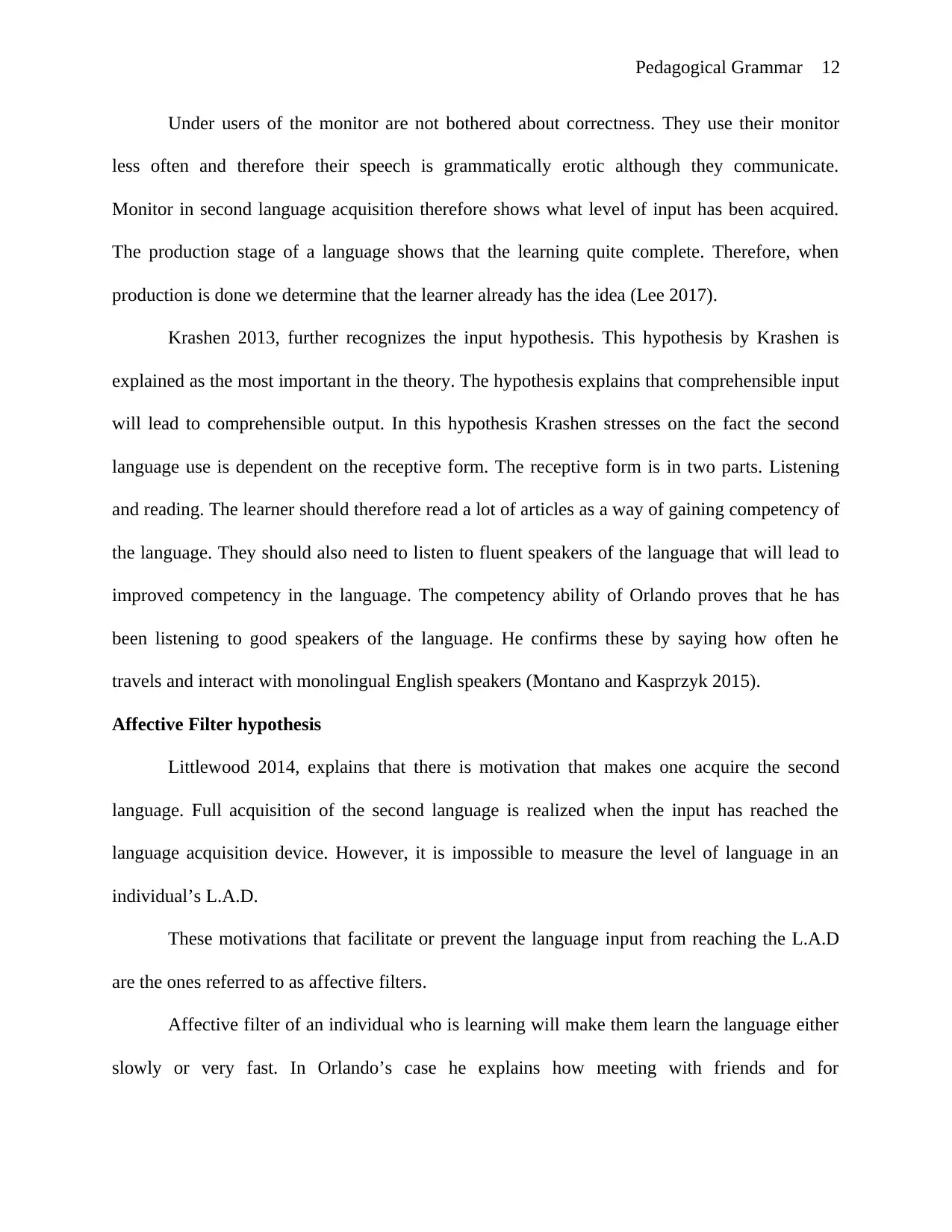
Pedagogical Grammar 12
Under users of the monitor are not bothered about correctness. They use their monitor
less often and therefore their speech is grammatically erotic although they communicate.
Monitor in second language acquisition therefore shows what level of input has been acquired.
The production stage of a language shows that the learning quite complete. Therefore, when
production is done we determine that the learner already has the idea (Lee 2017).
Krashen 2013, further recognizes the input hypothesis. This hypothesis by Krashen is
explained as the most important in the theory. The hypothesis explains that comprehensible input
will lead to comprehensible output. In this hypothesis Krashen stresses on the fact the second
language use is dependent on the receptive form. The receptive form is in two parts. Listening
and reading. The learner should therefore read a lot of articles as a way of gaining competency of
the language. They should also need to listen to fluent speakers of the language that will lead to
improved competency in the language. The competency ability of Orlando proves that he has
been listening to good speakers of the language. He confirms these by saying how often he
travels and interact with monolingual English speakers (Montano and Kasprzyk 2015).
Affective Filter hypothesis
Littlewood 2014, explains that there is motivation that makes one acquire the second
language. Full acquisition of the second language is realized when the input has reached the
language acquisition device. However, it is impossible to measure the level of language in an
individual’s L.A.D.
These motivations that facilitate or prevent the language input from reaching the L.A.D
are the ones referred to as affective filters.
Affective filter of an individual who is learning will make them learn the language either
slowly or very fast. In Orlando’s case he explains how meeting with friends and for
Under users of the monitor are not bothered about correctness. They use their monitor
less often and therefore their speech is grammatically erotic although they communicate.
Monitor in second language acquisition therefore shows what level of input has been acquired.
The production stage of a language shows that the learning quite complete. Therefore, when
production is done we determine that the learner already has the idea (Lee 2017).
Krashen 2013, further recognizes the input hypothesis. This hypothesis by Krashen is
explained as the most important in the theory. The hypothesis explains that comprehensible input
will lead to comprehensible output. In this hypothesis Krashen stresses on the fact the second
language use is dependent on the receptive form. The receptive form is in two parts. Listening
and reading. The learner should therefore read a lot of articles as a way of gaining competency of
the language. They should also need to listen to fluent speakers of the language that will lead to
improved competency in the language. The competency ability of Orlando proves that he has
been listening to good speakers of the language. He confirms these by saying how often he
travels and interact with monolingual English speakers (Montano and Kasprzyk 2015).
Affective Filter hypothesis
Littlewood 2014, explains that there is motivation that makes one acquire the second
language. Full acquisition of the second language is realized when the input has reached the
language acquisition device. However, it is impossible to measure the level of language in an
individual’s L.A.D.
These motivations that facilitate or prevent the language input from reaching the L.A.D
are the ones referred to as affective filters.
Affective filter of an individual who is learning will make them learn the language either
slowly or very fast. In Orlando’s case he explains how meeting with friends and for
⊘ This is a preview!⊘
Do you want full access?
Subscribe today to unlock all pages.

Trusted by 1+ million students worldwide
1 out of 17
Your All-in-One AI-Powered Toolkit for Academic Success.
+13062052269
info@desklib.com
Available 24*7 on WhatsApp / Email
![[object Object]](/_next/static/media/star-bottom.7253800d.svg)
Unlock your academic potential
Copyright © 2020–2025 A2Z Services. All Rights Reserved. Developed and managed by ZUCOL.
